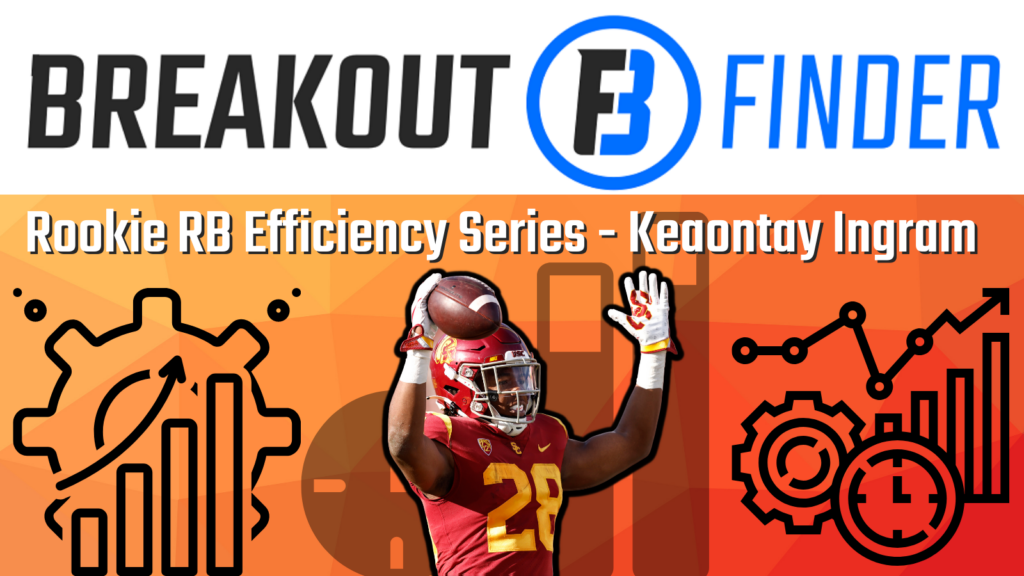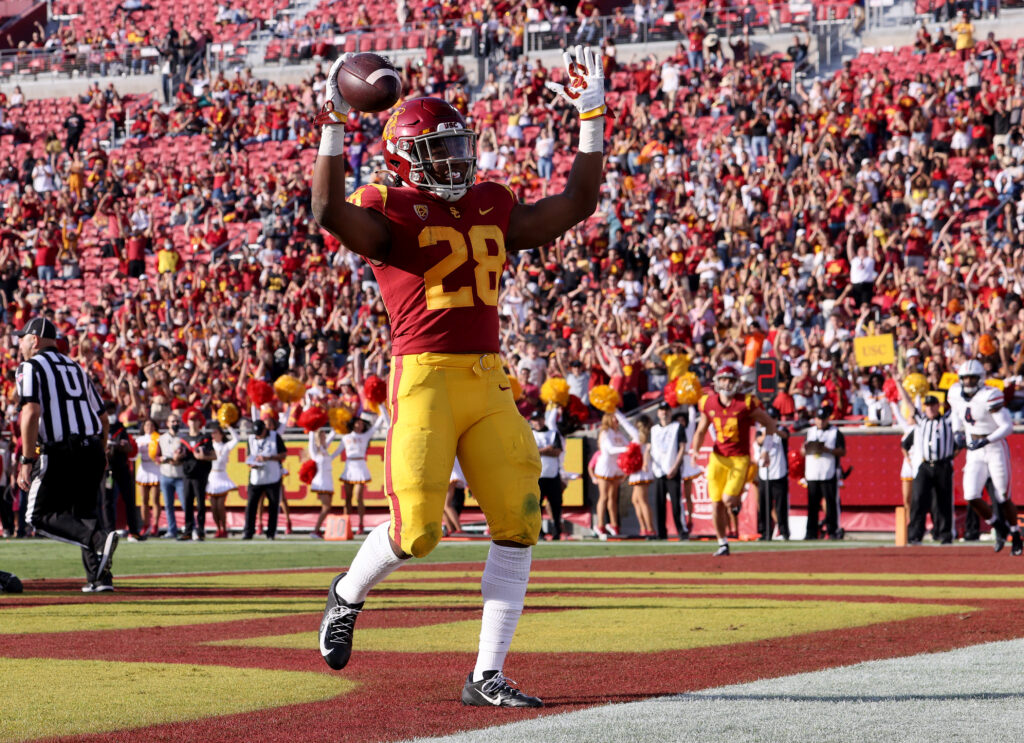
This article is part of a series in which I evaluate 2022 rookie running backs solely on their ability to run the ball. The first installments can be found here. I’ve changed up my methodology a bit since publishing those articles, which I go over in detail in this process-focused piece. I’ll give a quick refresher below, but also feel free to skip straight to the player-focused analysis below the picture of USC’s Keaontay Ingram a couple paragraphs down.
Outside the ability of whoever happens to be running the ball, there is a whole mess of variables that factor into the effectiveness of a given rushing attack: scheme, play-calling tendencies, opponent strength and scheme, weather, offensive line play, surrounding skill-position talent, etc. And given this entanglement, separating the contributions of the ball carrier from the offensive environment in which he operates is not a straightforward task. My approach to doing that is centered around measuring the degree to which a running back is over- or under-performing the per-carry output of the other running backs on his team.
Starting from the premise that good runners do more with what they are given than do bad runners, it stands to reason that, provided players are operating under generally the same conditions (like, for example, playing on the same team), better backs should produce more per carry than lesser backs. Using this logic, we can establish a baseline for comparing efficiency between players on the same team; for each running back, we can compare his performance (X) to the collective performance of every other running back on the team (Y). If X > Y (essentially, if dude is doing more with his carries than his teammates are with theirs), we can probably conclude that the player in question is a good player, at least to some relative degree.
Assuming that this is a sound method of evaluating running backs relative to their teammates, we can then extend our comparisons to players from other teams (we’re really just creating a baseline for efficiency comparisons similar to how Dominator Rating and other market share-based metrics create baselines for volume-based comparisons).
The key metrics I use to evaluate running back performance vs. that of their teammates are called Yards Per Carry+, Chunk Rate+, and a metric I developed recently called Box-Adjusted Efficiency Rating, or BAE. I also like to use a metric called Breakaway Conversion Rate, but that is not a teammate-relative measure and we’ll therefore look into it separately.
The metrics are pretty straightforward: YPC+ is the degree to which a player over- or under-performs his teammates in yards per carry, and Chunk Rate+ is the degree to which a player over- or under-performs his teammates in rate of “chunk” runs (which I classify as runs of 10 yards or more). At a basic level, I want my running back prospects to find a way to produce more per carry than the other backs on the team, and part of that puzzle is navigating the line of scrimmage and extending runs into the secondary at a higher rate than his backfield mates. YPC+ and Chunk Rate+ measure the degree to which a player does both of these things.
BAE also does those things, but it improves upon Yards Per Carry+ by using a weighted average of a player’s per carry efficiency on carries vs. various amounts of defenders in the box (using data from Sports Info Solutions), relative to the per carry efficiency of other running backs on his team vs. the same box counts. The resulting percentage indicates to what degree a runner over- or under-performed his teammates on his total rushing attempts, relative to how often he faced each box count. BAE is a more comprehensive metric than is YPC+, and I will defer to it accordingly, but YPC+ and Chunk Rate+ will still be used given that the sample of data I have for those metrics goes back a decade-plus (while I’m only able to generate BAE Ratings going back to the 2018 college football season).
THE METRICS

To just get it out of the way, USC Trojan (and former Texas Longhorn) Keaontay Ingram is not going to blow anybody away in the open field. He never put together a season in which he converted 10-yard runs into 20-yard runs at a rate above the 31st-percentile. His career Breakaway Conversion Rate of 23.34-percent is an 18th-percentile mark. It’s simply not his game.
What is his game is pretty much everything else. During his four-year career in both the Big 12 and the Pac-12, Ingram played with a group of backfield teammates who averaged 3.86 stars as recruits out of high school, a pedigree in the 76th-percentile among teammates of running back draftees going back to 2007. Ingram produced a BAE Rating of 109.1-percent against this group, producing more yards per carry than his teammates against each box count, save for 6-man boxes, where he produced at 99.6-percent his teammates’ per carry rate. In total, he saw 0.08 fewer men in the box than other Trojan and Longhorn backs on average, and took advantage of those lighter boxes by ripping off chunk gains of 10+ yards at a 4.13-percent greater clip than his teammates, a number in the 79th-percentile. He’s not often pulling away from defenders once he gets there, but he’s making frequent trips to the secondary, showing high-level ability to navigate the line of scrimmage and make dudes miss at the first level. During his highest-volume rushing season in 2021, Ingram actually outdid other Trojan runners by 9.26-percent in Chunk Rate, a rate that would be a 97th-percentile mark.
On the aggregate, Ingram’s ability to reach the secondary and his relative inability to escape from it — as well as the relatively light boxes he saw — resulted in a career YPC+ mark of 1.06, a 72nd-percentile number. The only season in which he didn’t outgain his teammates on a per carry basis by at least 0.86 yards was his junior season at Texas, the 2020 campaign that introduced the world to Bijan Robinson (in my opinion, there’s no shame in not being as good as Bijan, nobody else in college football is either). And if we just look at guys who played with as talented a group of running back teammates as Ingram did while handling as large a workload as Ingram did, the only other backs since 2007 to post a career YPC+ mark over the 1.00-yard threshold are Jamaal Charles, Sony Michel, Lamar Miller, Joe Mixon, Knowshon Moreno, Dalvin Cook, Elijah Hood, D’Onta Foreman, Todd Gurley, and Derrick Henry.
TO THE INFALLIBLE RB MODEL
According to my infallible running model’s Rushing Efficiency Score (a composite that accounts for all the non-BAE metrics I’ve touched on here in addition to overall team quality, offensive line play, and strength of opponent), Ingram scores a 63.3 out of 100. This gives him the third-highest score among 2022 backs (behind Kenneth Walker and James Cook), which, considering how much he’s being dragged down by his poor Breakaway Conversion Rate numbers (even a 50th-percentile showing there would bring his total score up to 69.6), says pretty good things about his ability as a runner.

I’ve been calling Keaontay Ingram the closest thing we’ve seen to Alvin Kamara since Kamara himeself for like two years now. My running back model’s comp machine (which generates comps using the same metrics as it uses for the Rushing Efficiency Score in addition to physical attributes like height, weight, and athletic testing numbers) happens to agree, at least in terms of rushing style and ability. If we assume that Ingram runs a 4.58 and is the 6-0, 215-pounds that he’s listed at on USC’s team website, the 10 players listed above are his most similar from a “pure runner” standpoint.
LAST WORD
It’s obviously a hard ask for any given player to have an Alvin Kamara–like impact in the NFL or in fantasy football, and I’m certainly not projecting that for Keaontay Ingram (he’s not quite the receiver Kamara is, anyway). What I do think is that Ingram is a badass runner of the football with workhorse size and a three-down skillset, which combine to make him my favorite under-the-radar running back in the 2022 class.


